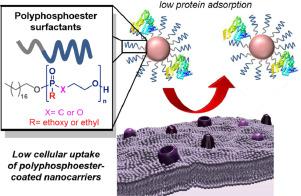Acta Biomaterialia ( IF 9.4 ) Pub Date : 2020-09-13 , DOI: 10.1016/j.actbio.2020.09.016 Kristin N Bauer 1 , Johanna Simon 2 , Volker Mailänder 2 , Katharina Landfester 1 , Frederik R Wurm 3

|
Opsonization of nanocarriers is one of the most important biological barriers for controlled drug delivery. The typical way to prevent such unspecific protein adsorption and thus fast clearance by the immune system is the covalent modification of drug delivery vehicles with poly(ethylene glycol) (PEG), so-called PEGylation. Recently, polyphosphoesters (PPEs) were identified as adequate PEG substitutes, however with the benefits of controllable hydrophilicity, additional chemical functionality, or biodegradability. Here, we present a general strategy by non-covalent adsorption of different nonionic PPE-surfactants to nanocarriers with stealth properties. Polyphosphoester surfactants with different binding motifs were synthesized by anionic ring-opening polymerization of cyclic phosphates or phosphonates and well-defined polymers were obtained. They were evaluated with regard to their cytotoxicity, protein interactions, and corona formation and their cellular uptake. We proved that all PPE-surfactants have lower cytotoxicity as the common PEG-based surfactant (Lutensol® AT 50) and that their hydrolysis is controlled by their chemical structure. Two polymeric nanocarriers, namely polystyrene and poly(methyl methacrylate), and bio-based and potentially biodegradable hydroxyethyl starch nanocarriers were coated with the PPE-surfactants. All nanocarriers exhibited reduced protein adsorption after coating with PPE-surfactants and a strongly reduced interaction with macrophages. This general strategy allows the transformation of polymeric nanocarriers into camouflaged nanocarriers and by the chemical versatility of PPEs will allow the attachment of additional moieties for advanced drug delivery.
中文翻译:

聚磷酸酯表面活性剂,作为聚合物纳米载体的通用隐形涂料。
纳米载体的调理作用是控制药物递送的最重要的生物学障碍之一。防止这种非特异性蛋白质吸附并因此被免疫系统快速清除的典型方法是用聚乙二醇(PEG)对药物递送载体进行共价修饰,即所谓的PEG化。最近,聚磷酸酯(PPE)被确定为适当的PEG替代品,但是具有可控的亲水性,附加的化学功能或生物降解性的优点。在这里,我们通过将不同的非离子PPE表面活性剂非共价吸附到具有隐身特性的纳米载体上,提出了一种通用策略。通过环状磷酸酯或膦酸酯的阴离子开环聚合反应,合成了具有不同结合基序的聚磷酸酯表面活性剂,得到了定义明确的聚合物。对它们的细胞毒性,蛋白质相互作用,电晕形成和细胞吸收进行了评估。我们证明,所有PPE-表面活性剂作为常见的基于PEG的表面活性剂(Lutensol®AT 50)均具有较低的细胞毒性,并且它们的水解受其化学结构控制。两种聚合物纳米载体,即聚苯乙烯和聚甲基丙烯酸甲酯,以及生物基的和潜在可生物降解的羟乙基淀粉纳米载体,都用PPE表面活性剂包被。用PPE表面活性剂包被后,所有纳米载体均表现出减少的蛋白质吸附,并且与巨噬细胞的相互作用大大降低。











































 京公网安备 11010802027423号
京公网安备 11010802027423号